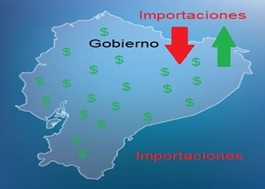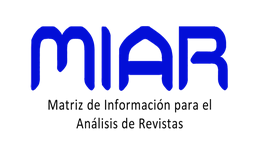Effect of public spending on the level of imports in Ecuador, 2000-2020
DOI:
https://doi.org/10.17981/econcuc.43.2.2022.Econ.2Keywords:
Aggregate demand, Dollarization, Offer added, Public spending, Non-financial public sector, Imports, ElasticityAbstract
In the last decade, increasing in public spending in the Ecuadorian economy was notorious, causing different effects on all components of the aggregate supply. This research work aims to measure the effect of public spending in the non-financial sector on the behavior of total imports, taking data from the Central Bank of Ecuador in the period between the third quarter of 2000 and the second quarter of 2020. This analysis was performed using a classical linear regression model based on Ordinary Least Squares (OLS). It was determined that public spending explains the level of imports at 42.92% and in turn, imports show inelastic reactions to public spending.
Downloads
References
Abel, A., Bernanke, B. & Croushore, D. (2017). Macroeconomics. Boston: Pearson.
Abbott, A. & Seddighi, H. (1996). Aggregate imports and expenditure components in the UK: An empirical analysis. Applied Economics, 28(9), 1119–1125. https://doi.org/10.1080/000368496327967
Al Fagha, A. & El Hadj, S. (2020). Aggregate Import Demand Function in Mauritania: Cointegration Analysis. Alternatives Managériales et Economiques, 2(3), 383–401. https://doi.org/10.48374/IMIST.PRSM/ame-v2i3.22182
Ahmed, S. (1987). Government spending, the balance of trade and the terms of trade in British history. Journal of Monetary Economics, 20(2), 195–220. https://doi.org/10.1016/0304-3932(87)90014-6
Albornoz, M. (2018). Elasticidades del comercio exterior en América Latina. Estimaciones para 1993-2014. Ciclos en la Historia, la Economía y la Sociedad, 29(50), 61–86. Recuperado de https://ojs.econ.uba.ar/index.php/revista-CICLOS/article/view/1237
Albornoz, V. (2009). El país compró al exterior más que nunca minería: no todo lo que brilla es oro. Gestión, (178), 22–24. Recuperado de https://revistagestion.ec/sites/default/files/import/legacy_pdfs/178_003.pdf
Alexiou, C. (2010). An empirical note on government expenditure and imports: An ARDL cointegration investigation. Rivista Internazionale di Scienze Sociali, (2), 263–274. https://doi.org/https://doi.org/10.1400/209711
Asaana, C. & Sakyi, D. (2020). Empirical Analysis of Demand for Imports in Sub-Saharan Africa. International Trade Journal, 35(4), 360–382. https://doi.org/10.1080/08853908.2020.1832938
Beetsma, R., Giuliodori, M. & Klaassen, F. (2008). The effects of public spending shocks on trade balances and budget deficits in the European Union. Journal of the European Economic Association, 6(2–3), 414–423. https://doi.org/10.1162/JEEA.2008.6.2-3.414
Benarroch, M. & Pandey, M. (2017). The Impact of Imports and Exports on the Size and Composition of Government Expenditures. International Journal of Economics and Finance, 9(3), 57–68. https://doi.org/10.5539/ijef.v9n3p57
Blanchard, O. & Perotti, R. (2002). An empirical characterization of the dynamic effects of changes in government spending and taxes on output. The Quarterly Journal of Economics, 117(4), 1329–1368. https://doi.org/10.1162/003355302320935043
Blanchard, O., Amighini, A. & Giavazzi, F. (2017). Macroeconomía. Madrid: Pearson Education.
Calva, J. & Silva, K. (2019). Incidencia del gasto público en las importaciones para Ecuador, Colombia, Brasil y Venezuela; utilizando series de tiempo. Revista Económica, 6(1), 100–110. Disponible en https://revistas.unl.edu.ec/index.php/economica/article/view/795
Carrillo, P. (2015). Efectos macroeconómicos de la política fiscal en Ecuador 1993- 2009. Analítika. Revista de Análisis Estadístico, 9, 23–52. Recuperado de https://www.ecuadorencifras.gob.ec/documentos/web-inec/Revistas/Analitika/Anexos_pdf/Analit_09/2.pdf
CBE. (2017). Metodología. Información estadística mensual. [4 ed.]. Quito: El Telegrafo. Recuperado de https://contenido.bce.fin.ec/documentos/Publicaciones-Notas/Catalogo/IEMensual/metodologia/esf4taed.pdf
CBE. (2020a). Saldo acumulado balanza comercial % PIB. BCE. Disponible en https://contenido.bce.fin.ec/documentos/Administracion/bi_menuComercioExterior.html
CBE. (2020b). Información económica y estadísticas. BCE. Disponible en https://www.bce.fin.ec/index.php/informacioneconomica
CBE. (2020c). Reporte de información estadística mensual (IEM). BCE. Disponible en https://contenido.bce.fin.ec/home1/estadisticas/bolmensual/IEMensual.jsp
Clancy, D., Jacquinot, P. & Lozej, M. (2016). Government expenditure composition and fiscal policy spillovers in small open economies within a monetary union. Journal of Macroeconomics, 48, 305–326. https://doi.org/10.1016/j.jmacro.2016.04.003
Crespo, C. (2019). Análisis del impacto del gasto público del gobierno central en la balanza comercial en el Ecuador. Periodo 2002–2017. [Tesis de grado]. Universidad del Azuay, Cuenca, Ecuador. Disponible en http://dspace.uazuay.edu.ec/handle/datos/8841
Eviews. (versión 10). Paquete estadístico. [Software]. McLean: Quantitative Micro Software-QMS. Disponible en https://eviews.com/download/downloadfull_10.shtml
Ganelli, G. & Tervala, J. (2009). Can government spending increase private consumption? The role of complementarity. Economics Letters, 103(1), 5–7. https://doi.org/10.1016/j.econlet.2009.01.007
Giovannetti, G. (1989). Aggregate imports and expenditure components in Italy: An econometric analysis. Applied Economics, 21(7), 957–971. https://doi.org/10.1080/758518236
Gujarati, D. & Porter, D. (2010). Econometría. México, D.F.: McGraw Hill.
ICC. (2020). Incoterms® 2020 practical free wallchart. Atlantic City: ICC. Available: https://iccwbo.org/publication/incoterms-2020-practical-free-wallchart/
IMF. (2009). Manual de la Balanza de Pagos y Posición de Inversión Internacional (6 ed.). Washington D.C.: FMI. Recuperado de https://www.imf.org/~/media/Websites/IMF/imported-publications-loe-pdfs/external/spanish/pubs/ft/bop/2007/bopman6s.ashx
Keynes, J. (1943). Teoría general de la ocupación, el interés y el dinero. México D.F.: Fondo de cultura económica.
Kim, S. & Roubini, N. (2008). Twin deficit or twin divergence? Fiscal policy, current account, and real exchange rate in the U.S. Journal of International Economics, 74(2), 362–383. https://doi.org/10.1016/j.jinteco.2007.05.012
Konstantakopoulou, I. (2017). The effects of government expenditure on imports in the Eurozone reconsidered: evidence from panel data. Applied Economics, 50(30), 3231–3239. https://doi.org/10.1080/00036846.2017.1418081
Krugman, P., Obstfeld, M. & Melitz, M. (2017). International Economics: Theory & Policy. London: Pearson.
Lane, P. & Perotti, R. (2003). The importance of composition of fiscal policy: Evidence from different exchange rate regimes. Journal of Public Economics, 87(9–10), 2253–2279. https://doi.org/10.1016/S0047-2727(01)00194-3
Larraín, F. (2004). Macroeconomía en la práctica. México D.F.: Pearson.
Majeed, S. (2019). Modeling the effects of macroeconomic expenditure components on Pakistan’s import from China. Journal of Economic Cooperation & Development, 40(2), 101–122. https://www.sesric.org/publications-jecd.php
Mankiw, G. (2014). Macroeconomía. [8 ed.]. Barcelona: Antoni Bosch.
Marshall, A. (1920). Principles of Economics and Introductory Volume. New York: Macmillan Publishers Ltd.
Mochón, F. (2009). Economía, Teoría y Política. Madrid: McGraw-Hill Interamericana.
Müller, G. (2008). Understanding the dynamic effects of government spending on foreign trade. Journal of International Money and Finance, 27(3), 345–371. https://doi.org/10.1016/j.jimonfin.2008.01.005
Murphy, D. (2015). How can government spending stimulate consumption? Review of Economic Dynamics, 18(3), 551–574. https://doi.org/10.1016/j.red.2014.09.006
Parkin, M. (2018). Economía. México, D.F.: Pearson Educación.
Puig, J. (2015). Multiplicador del gasto público en Bolivia: una primera aproximación. Lajed, (24), 47–78. https://doi.org/https://doi.org/10.35319/lajed.20152469
Ravn, M., Schmitt-Grohé, S. & Uribe, M. (2012). Consumption, government spending, and the real exchange rate. Journal of Monetary Economics, 59(3), 215–234. https://doi.org/10.1016/j.jmoneco.2012.02.001
República de Ecuador. Comité de Comercio Exterior. (6 de marzo de 2015). Resolución 011-2015. Disponible en https://www.aduana.gob.ec/archivos/Boletines/ 2015/resolucion_011_2015%20Comex.pdf
Shen, W., Yang, S. & Zanna, L. (2018). Government spending effects in low-income countries. Journal of Development Economics, 133, 201–219. https://doi.org/10.1016/j.jdeveco.2018.02.005
Spilimbergo, A., Symansky, S. & Schindler, M. (2009). Fiscal Multipliers. IMF Staff Position Note. [SPN/09/11]. Washington DC: IMF. Available from https://www.imf.org/external/pubs/ft/spn/2009/spn0911.pdf
Tagkalakis, A. (2014). Discretionary fiscal policy and economic activity in Greece. Empirica, 41, 687–712. https://doi.org/10.1007/s10663-013-9232-0
Thomas, A. (2021). Macroeconomics: An Introduction. Cambridge: Cambridge University Press.
Uriel, E. (2013). El modelo de regresión simple: estimación y propiedades. En E. Uriel, Introducción a la Econometría (pp. 15–64). Valencia: Universidad de Valencia. Disponible en https://www.uv.es/uriel/libroes.htm
Vacu, N. & Odhiambo, N. (2020). The Determinants of Import Demand in South Africa: An Empirical Investigation. Economia Internazionale/International Economics, 73(1), 51–76. Available: https://ideas.repec.org/a/ris/ecoint/0863.html
Vacu, N. & Odhiambo, N. (2019). The determinants of aggregate and disaggregated import demand in Ghana. African Journal of Economic and Management Studies, 10(3), 356–367. https://doi.org/10.1108/AJEMS-08-2018-0246
Yoon, I. & Kim, Y.-M. (2019). Estimating Import Demand Function for the United States. Asia-Pacific Journal of Business, 10(2), 13–26. https://doi.org/10.32599/apjb.10.2.201906.13

Published
How to Cite
Issue
Section
License
Copyright (c) 2022 Carlos Joaquín Crespo Cordero, Econ., Luis Bernardo Tonon Ordóñez, Luis Gabriel Pinos Luzuriaga, Econ.

This work is licensed under a Creative Commons Attribution-NonCommercial-NoDerivatives 4.0 International License.
You are free to:
- Share — copy and redistribute the material in any medium or format
- The licensor cannot revoke these freedoms as long as you follow the license terms.
Under the following terms:
- Attribution — You must give appropriate credit , provide a link to the license, and indicate if changes were made . You may do so in any reasonable manner, but not in any way that suggests the licensor endorses you or your use.
- NonCommercial — You may not use the material for commercial purposes .
- NoDerivatives — If you remix, transform, or build upon the material, you may not distribute the modified material.
- No additional restrictions — You may not apply legal terms or technological measures that legally restrict others from doing anything the license permits.

 English
English
 Español (España)
Español (España)














